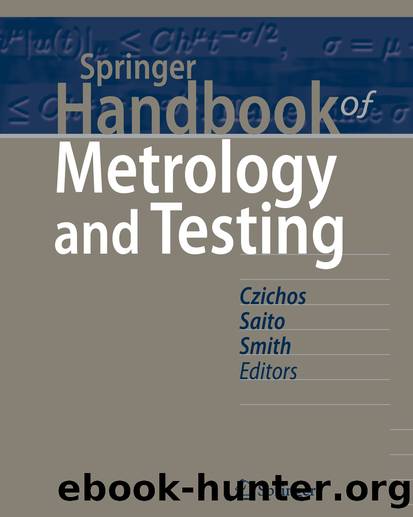Springer Handbook of Metrology and Testing by Horst Czichos Tetsuya Saito & Leslie Smith

Author:Horst Czichos, Tetsuya Saito & Leslie Smith
Language: eng
Format: epub
Publisher: Springer Berlin Heidelberg, Berlin, Heidelberg
10.3.3 Calibration [1]
10.3.3.1 Field Calibration
The field is calibrated using a small pickup coil whose effective winding area is known from an NMR calibration. The induced voltage u(t) is then fitted using (10.53), in order to determine the field calibration factor k, the damping factor and the pulse duration (including the effect of the damping)
(10.53)
The damping factor a determined in this way can be compared with the value given by a PFM circuit using a ≈ R/2L (where R is the resistivity of the pulse magnet, and L is the inductivity of the pulse magnet).
The calibration factor k is also determined as a function of the gain (integrator gain and the gain of preamplifier). The calibration factor k gives a relation between the induced voltage and the field at the search coil. At the same time the integrated voltage (using different gain factors) of the H-measuring coil (which is located at the pickup rod) on the magnetometer system is recorded.
It was shown that the calibration factor k was also determined as a function of the gain using an analogue integrator [1]. The scattering of the k factor was below ±1%. This indicates that the linearity of the gain is better than 1%. Using such a procedure, an absolute field calibration of better than 1% is achieved, including the time constants (gain) of the integrator.
Download
This site does not store any files on its server. We only index and link to content provided by other sites. Please contact the content providers to delete copyright contents if any and email us, we'll remove relevant links or contents immediately.
| Automotive | Engineering |
| Transportation |
Whiskies Galore by Ian Buxton(41097)
Introduction to Aircraft Design (Cambridge Aerospace Series) by John P. Fielding(32490)
Small Unmanned Fixed-wing Aircraft Design by Andrew J. Keane Andras Sobester James P. Scanlan & András Sóbester & James P. Scanlan(32231)
Craft Beer for the Homebrewer by Michael Agnew(17565)
Turbulence by E. J. Noyes(7239)
The Complete Stick Figure Physics Tutorials by Allen Sarah(6769)
Kaplan MCAT General Chemistry Review by Kaplan(6171)
The Thirst by Nesbo Jo(5944)
Bad Blood by John Carreyrou(5895)
Modelling of Convective Heat and Mass Transfer in Rotating Flows by Igor V. Shevchuk(5828)
Learning SQL by Alan Beaulieu(5605)
Weapons of Math Destruction by Cathy O'Neil(5229)
Man-made Catastrophes and Risk Information Concealment by Dmitry Chernov & Didier Sornette(4955)
iGen by Jean M. Twenge(4804)
Digital Minimalism by Cal Newport;(4804)
Life 3.0: Being Human in the Age of Artificial Intelligence by Tegmark Max(4656)
Design of Trajectory Optimization Approach for Space Maneuver Vehicle Skip Entry Problems by Runqi Chai & Al Savvaris & Antonios Tsourdos & Senchun Chai(4508)
Audition by Ryu Murakami(4235)
Electronic Devices & Circuits by Jacob Millman & Christos C. Halkias(4209)
